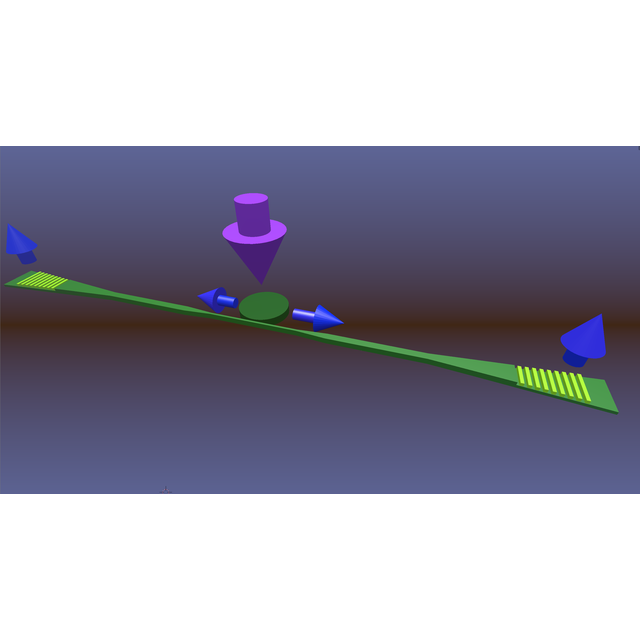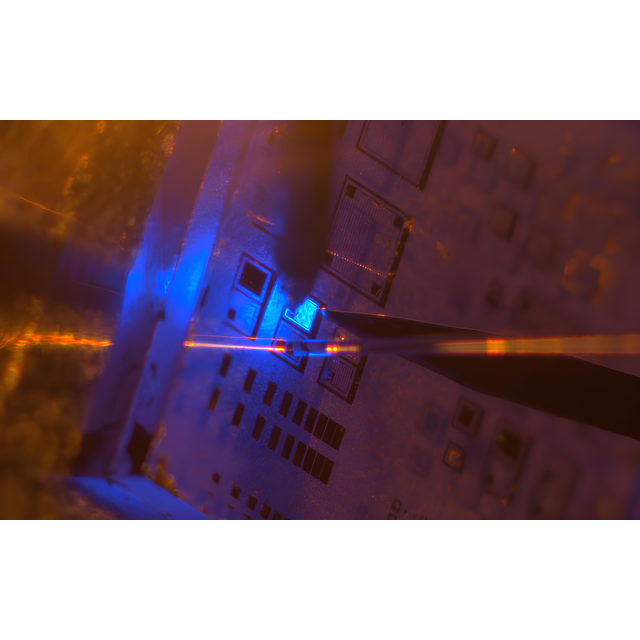A consortium of researchers has fabricated the first blue microlaser integrated into a photonic circuit. This device is a step towards demonstrating the viability of the III-nitride on silicon semiconductor photonic platform.
Nanophotonics utilizing the group III-nitride on silicon platform is an exciting new field that opens potential applications from the ultraviolet (UV) to the infrared (IR) spectral range. These applications could span innovative display, lighting and communication technologies, quantum information processing, and biocompatible applications. Despite abounding research and demonstration of elementary building blocks like single microlasers and passive photonic circuits, the monolithic coupling between an active source in the blue and a photonic circuit integrated on silicon was still to be demonstrated.
Within a consortium of researchers, Farsane Tabataba-Vakili, PhD Student at the Centre de Nanosciences et de Nanotechnologies - C2N (CNRS/Univ. Paris-Sud) and the Institut Nanosciences et Cryogénie – INAC (CEA/Univ. Grenoble Alpes), demonstrated the first blue microlaser integrated into a photonic circuit. The work was recently published in the ACS Photonics journal. Farsane received the Best Student Poster Award for the presentation of this work during the 34th International Conference on the Physics of Semiconductors (ICPS 2018) that took place in Montpellier from 29 July to 3 August 2018.
The monolithic device consists in an active microdisk of 3-5µm diameter side-coupled to a bus waveguide. Out-coupling gratings terminating the waveguide ensure the side extraction of the coherent light. The gap between the microdisk and the waveguide is a key design parameter that must be finely tuned for efficient light coupling. One of the challenges was to fabricate gaps smaller than 100 nm, which was achieved thanks to the group-III nitride technology developed in the C2N team. Under low-power continuous-wave excitation the researchers observe large loaded quality factors (Q factors) for these materials, of around 2000. Under pulsed optical pumping they observe lasing with a threshold of 15 mJ/cm2 per pulse.
Electrical injection in these low footprint resonators is under development for integration purposes. Supported by an international research project*, of which Farsane is a very active member, the researchers now seek blue/UV lasing of electrically injected microdisks to provide highly efficient white light sources. Indeed, unlike white LEDs, laser based micro-emitters do not have a decreased efficiency at high injection, a well-known limiting phenomenon in LED technologies known as “droop”.
This work thus represents an important step towards showing the viability of the III-nitride on silicon photonic platform
* ANR MilaGaN : collaboration between C2N (CNRS/UPSud), CRHEA (CNRS/ Univ. Côte d’Azur), INAC (CEA/Univ. Grenoble Alpes), L2C (CNRS/Univ. Montpellier), and the Hong Kong University (HKU). Funded by Agence Nationale de la Recherche (ANR-17-CE08-0043-02).
Reference:
Blue Microlasers Integrated on a Photonic Platform on Silicon,
Farsane Tabataba-Vakili1,2, Laetitia Doyennette3, Christelle Brimont3, Thierry Guillet3, Stéphanie Rennesson4, Eric Frayssinet4, Benjamin Damilano4, Jean-Yves Duboz4, Fabrice Semond4, Iannis Roland1, Moustafa El Kurdi1, Xavier Checoury1, Sébastien Sauvage1, Bruno Gayral2 and Philippe Boucaud1,4
ACS Photonics (July 2018)
DOI: 10.1021/acsphotonics.8b00542
1 Centre de Nanosciences et de Nanotechnologies – C2N (CNRS / Université Paris-Sud- Université Paris-Saclay)
2 Institut Nanosciences et Cryogénie – INAC (CEA/Université Grenoble Alpes)
3 Laboratoire Charles Coulomb - L2C (CNRS/Université de Montpellier)
4 Centre de recherche sur l'hétéroepitaxie et ses applications - CRHEA (CNRS/Université Côte d’Azur)
Contact:
Farsane Tabataba-Vakili, PhD Student at C2N and INAC
Figure: III-nitride microdisk laser photonic circuit consisting of a disk coupled to a bus waveguide terminated by out-coupling gratings. Copyright © 2018 American Chemical Society









